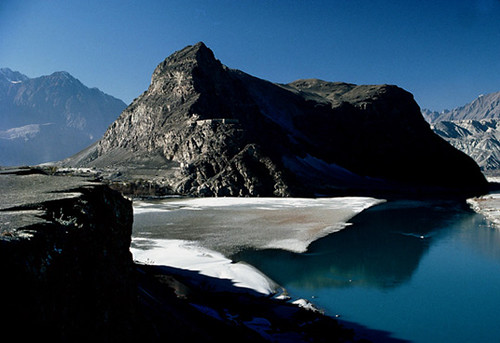Nestled in the midst of the snow-capped peaks of the Karakorum Mountains, glaciers and green valleys, lies Skardu Valley's alpine desert – a carpet of silvery white sand and wind ribbed dunes. The Valley is also known as 'Little Tibet' and stands at an altitude of 2,438 metres; with the lofty peaks of the Karakorum Mountains as a backdrop, the Skardu Valley is a veritable tourist's paradise.
Locals trek across the alpine desert of Sundus in the Skardu Valley. This mountain desert is made up of a carpet of silvery white sand and wind ribbed dunes. The majestic, snow-capped Karakorum Mountains serve as a backdrop. The Valley, also known as 'Little Tibet' stands at an altitude of 2,438 metres and is a veritable tourist's paradise
The River Indus meanders through the mountain ranges at Kachura in the Gilgit-Baltistan area, where it attains its widest expanse. The Indus originates in Mount Kailash in Tibet and finds its way into Pakistan through the snow-capped peaks of the Karakorum Mountains in Gilgit-Baltistan. It runs south throughout Pakistan until it reaches the Arabian Sea near Karachi.
The Gwadar Port was built on a turnkey basis by China. It was inaugurated in the spring of 2007 by then Pakistani President General Pervez Musharraf. Gwadar Port is now being expanded into a deep sea port and naval base with Chinese technical and financial assistance. Gwadar Port became operational in 2008 with the first ship to dock bringing 52,000 tonnes of wheat from Canada. Pakistan's Minister of Ports and Shipping, Sardar Nabil Ahmed Khan Gabol, officially inaugurated the port on 21 December 2008. China has acknowledged that Gwadar's strategic value is no less than that of theKarakoram Highway, which helped cement the China-Pakistan relationship. Beijing is also interested in turning it into an energy-transport hub by building an oil pipeline from Gwadar into China's Xinjiang region. The planned pipeline will carry crude oil sourced fromArab and African states. Such transport by pipeline will cut freight costs and also help insulate the Chinese imports from interdiction by hostile naval forces in case of any major war. Commercially, it is hoped that the Gwadar Port would generate billions of dollars inrevenues and create at least two million jobs. In 2007, the government of Pakistan handed over port operations to PSA Singapore for 25 years, and gave it the status of a Tax Free Port for the following 40 years. The main investors in the project are thePakistani Government and the People's Republic of China, making China's plan to be engaged in many places along oil and gas roads evidenT.
Khurram Gardezi
http://first-pakistan.blogspot.com
http://dcpakistan.blogspot.com
http://world-cricket-legends.blogspot.com
Golden fields of ripened wheat and lush green fruit trees colour the landscape of Chino village in the Saltoro Valley. The Valley lies at the foothills of the Saltoro Range, a sub-range of the Karakorum Mountains; it is the last settlement before the trek to the mighty Siachen Glacier.
Named after a general in Alexander the Great's army, Ormara is located on the Makran Coast along the Arabian Sea. It is a quaint seaside town, and most of the residents are fishermen. Despite the presence of a naval base, life here is simple; the beaches are beautiful and the scenery breathtaking. The beach is also a nesting place for the Olive Ridley and Green turtles, both of which are endangered.
Gwadar is located on the Makran Coast along the Arabian Sea. Other than its strategic position as Pakistan's newest port (inaugurated in 2008), Gwadar is known for is unspoiled beaches. Here, vertical cliffs hedge the golden sand beaches which undulate into the blue waters of the Arabian Sea. Marine life is abundant and Gwadar's sea food is reputed.

A woman busy with her handiwork wears the distinctive attire of Kalash women: long black robes, embroidered with cowries and beads. The women style their hair in multiple braids and wear elaborate headgears. The Kalash are Pakistan's last pagan tribe and live in enclaves in the Rumbur, Bumboret and Birir Valleys of Chitral District in Khyber Pakhtunkhwa; they strictly adhere to their traditions and claim to be the descendants of Alexander the Great.
The Nanga Parbat (Naked Mountain) forms the western anchor of the Himalayas. Reaching the majestic height of 8,126 metres, it is the ninth highest peak in the world and is considered one of the deadliest mountains to conquer.
The Hingol National Park is named after the turquoise Hingol River that snakes through the austere Balochi landscape. It is a remote area that supports diverse ecosystems. Hingol is a wildlife sanctuary for endangered animals and migratory birds. It was declared a park in 1988 and covers 6,190 square kilometres. Hinglaj Mandir, a popular Hindu pilgrimage site lies within the Park.


the Great Tibetan Empire, the rock is carved with drawings of stupas and
images of Buddha along with text; it is the only surviving rock of its kind
in the area. The Skardu Valley is also known as ‘Little Tibet’ and stands at
an altitude of 2,438 metres; with the lofty peaks of the Karakorum Mountains
as a backdrop, the Valley is a veritable tourist’s paradise. *
Khurram Gardezi
first-pakistan.blogspot.com
dcpakistan.blogspot.com
world-cricket-legends.blogspot.com